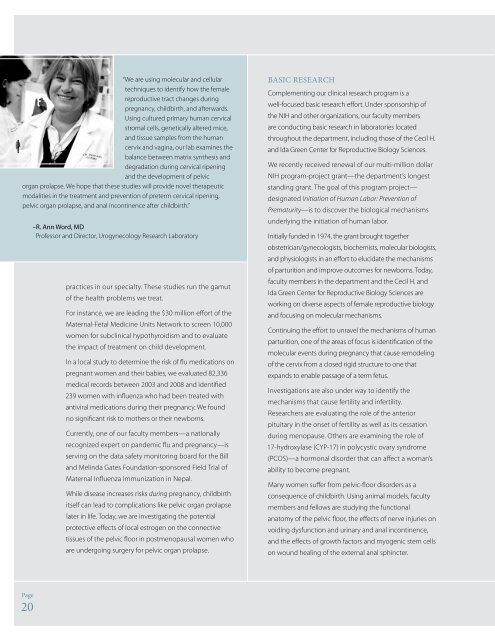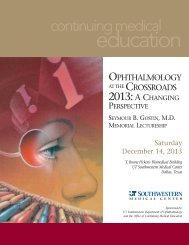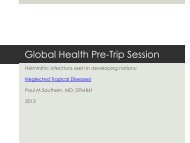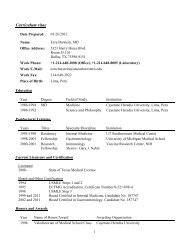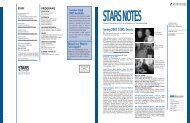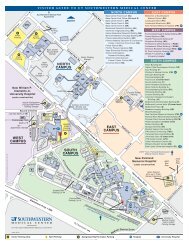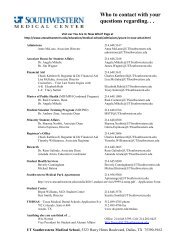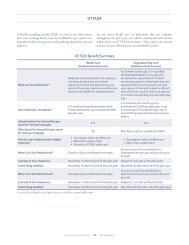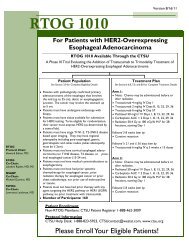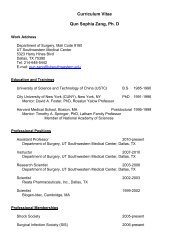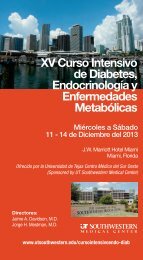Department of Obstetrics and Gynecology - UT Southwestern
Department of Obstetrics and Gynecology - UT Southwestern
Department of Obstetrics and Gynecology - UT Southwestern
You also want an ePaper? Increase the reach of your titles
YUMPU automatically turns print PDFs into web optimized ePapers that Google loves.
“We are using molecular <strong>and</strong> cellular<br />
techniques to identify how the female<br />
reproductive tract changes during<br />
pregnancy, childbirth, <strong>and</strong> afterwards.<br />
Using cultured primary human cervical<br />
stromal cells, genetically altered mice,<br />
<strong>and</strong> tissue samples from the human<br />
cervix <strong>and</strong> vagina, our lab examines the<br />
balance between matrix synthesis <strong>and</strong><br />
degradation during cervical ripening<br />
<strong>and</strong> the development <strong>of</strong> pelvic<br />
organ prolapse. We hope that these studies will provide novel therapeutic<br />
modalities in the treatment <strong>and</strong> prevention <strong>of</strong> preterm cervical ripening,<br />
pelvic organ prolapse, <strong>and</strong> anal incontinence after childbirth.”<br />
–R. Ann Word, MD<br />
Pr<strong>of</strong>essor <strong>and</strong> Director, Urogynecology Research Laboratory<br />
practices in our specialty. These studies run the gamut<br />
<strong>of</strong> the health problems we treat.<br />
For instance, we are leading the $30 million effort <strong>of</strong> the<br />
Maternal-Fetal Medicine Units Network to screen 10,000<br />
women for subclinical hypothyroidism <strong>and</strong> to evaluate<br />
the impact <strong>of</strong> treatment on child development.<br />
In a local study to determine the risk <strong>of</strong> flu medications on<br />
pregnant women <strong>and</strong> their babies, we evaluated 82,336<br />
medical records between 2003 <strong>and</strong> 2008 <strong>and</strong> identified<br />
239 women with influenza who had been treated with<br />
antiviral medications during their pregnancy. We found<br />
no significant risk to mothers or their newborns.<br />
Currently, one <strong>of</strong> our faculty members—a nationally<br />
recognized expert on p<strong>and</strong>emic flu <strong>and</strong> pregnancy—is<br />
serving on the data safety monitoring board for the Bill<br />
<strong>and</strong> Melinda Gates Foundation-sponsored Field Trial <strong>of</strong><br />
Maternal Influenza Immunization in Nepal.<br />
While disease increases risks during pregnancy, childbirth<br />
itself can lead to complications like pelvic organ prolapse<br />
later in life. Today, we are investigating the potential<br />
protective effects <strong>of</strong> local estrogen on the connective<br />
tissues <strong>of</strong> the pelvic floor in postmenopausal women who<br />
are undergoing surgery for pelvic organ prolapse.<br />
Basic Research<br />
Complementing our clinical research program is a<br />
well-focused basic research effort. Under sponsorship <strong>of</strong><br />
the NIH <strong>and</strong> other organizations, our faculty members<br />
are conducting basic research in laboratories located<br />
throughout the department, including those <strong>of</strong> the Cecil H.<br />
<strong>and</strong> Ida Green Center for Reproductive Biology Sciences.<br />
We recently received renewal <strong>of</strong> our multi-million dollar<br />
NIH program-project grant—the department’s longest<br />
st<strong>and</strong>ing grant. The goal <strong>of</strong> this program project—<br />
designated Initiation <strong>of</strong> Human Labor: Prevention <strong>of</strong><br />
Prematurity—is to discover the biological mechanisms<br />
underlying the initiation <strong>of</strong> human labor.<br />
Initially funded in 1974, the grant brought together<br />
obstetrician/gynecologists, biochemists, molecular biologists,<br />
<strong>and</strong> physiologists in an effort to elucidate the mechanisms<br />
<strong>of</strong> parturition <strong>and</strong> improve outcomes for newborns. Today,<br />
faculty members in the department <strong>and</strong> the Cecil H. <strong>and</strong><br />
Ida Green Center for Reproductive Biology Sciences are<br />
working on diverse aspects <strong>of</strong> female reproductive biology<br />
<strong>and</strong> focusing on molecular mechanisms.<br />
Continuing the effort to unravel the mechanisms <strong>of</strong> human<br />
parturition, one <strong>of</strong> the areas <strong>of</strong> focus is identification <strong>of</strong> the<br />
molecular events during pregnancy that cause remodeling<br />
<strong>of</strong> the cervix from a closed rigid structure to one that<br />
exp<strong>and</strong>s to enable passage <strong>of</strong> a term fetus.<br />
Investigations are also under way to identify the<br />
mechanisms that cause fertility <strong>and</strong> infertility.<br />
Researchers are evaluating the role <strong>of</strong> the anterior<br />
pituitary in the onset <strong>of</strong> fertility as well as its cessation<br />
during menopause. Others are examining the role <strong>of</strong><br />
17-hydroxylase (CYP-17) in polycystic ovary syndrome<br />
(PCOS)—a hormonal disorder that can affect a woman’s<br />
ability to become pregnant.<br />
Many women suffer from pelvic-floor disorders as a<br />
consequence <strong>of</strong> childbirth. Using animal models, faculty<br />
members <strong>and</strong> fellows are studying the functional<br />
anatomy <strong>of</strong> the pelvic floor, the effects <strong>of</strong> nerve injuries on<br />
voiding dysfunction <strong>and</strong> urinary <strong>and</strong> anal incontinence,<br />
<strong>and</strong> the effects <strong>of</strong> growth factors <strong>and</strong> myogenic stem cells<br />
on wound healing <strong>of</strong> the external anal sphincter.<br />
Page<br />
20


